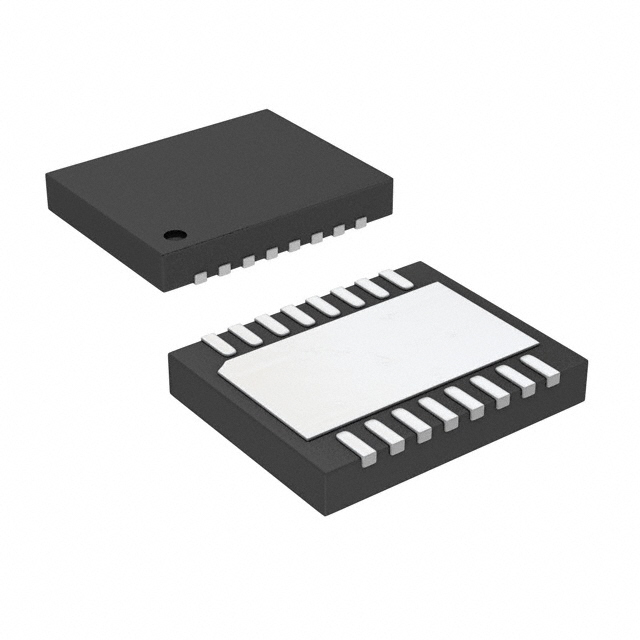LTC4353CDE#TRPBF
Product Overview
- Category: Integrated Circuit (IC)
- Use: Power Management
- Characteristics: High voltage ideal diode controller
- Package: 12-pin DFN (Dual Flat No-Lead)
- Essence: Efficiently controls the flow of current in power management systems
- Packaging/Quantity: Tape and Reel, 2500 units per reel
Specifications
- Input Voltage Range: 4V to 80V
- Operating Temperature Range: -40°C to 85°C
- Quiescent Current: 50µA
- Reverse Leakage Current: 1µA
- Overvoltage Lockout Threshold: 82V
- Reverse Input Voltage: -80V
- Maximum Continuous Output Current: 10A
Detailed Pin Configuration
- GATE: Gate drive output for external N-channel MOSFET
- VIN: Positive input voltage
- VOUT: Output voltage
- GND: Ground reference
- FB: Feedback pin for adjusting the overvoltage lockout threshold
- OVLO: Overvoltage lockout pin
- EN: Enable pin for turning on/off the device
- UVLO: Undervoltage lockout pin
- SS: Soft-start capacitor connection
- PG: Power good indicator
- NC: No connection
- NC: No connection
Functional Features
- Controls the forward voltage drop across an external N-channel MOSFET
- Provides reverse voltage protection
- Enables seamless switchover between power sources
- Offers adjustable overvoltage lockout threshold
- Implements undervoltage lockout protection
- Incorporates soft-start functionality
- Monitors power good status
Advantages and Disadvantages
Advantages: - Efficiently manages power flow in high voltage applications - Provides reverse voltage protection, preventing damage to the circuit - Allows seamless switching between power sources - Adjustable overvoltage lockout threshold for customization - Incorporates undervoltage lockout protection for added safety - Soft-start functionality reduces inrush current during startup - Power good indicator ensures reliable operation
Disadvantages: - Limited maximum continuous output current of 10A - Requires an external N-channel MOSFET for operation
Working Principles
The LTC4353CDE#TRPBF is a high voltage ideal diode controller that utilizes an external N-channel MOSFET to control the forward voltage drop. It operates by monitoring the input voltage and comparing it with the overvoltage lockout threshold. If the input voltage exceeds this threshold, the device turns off the MOSFET, preventing current flow in the reverse direction. When the input voltage drops below the undervoltage lockout threshold, the device turns on the MOSFET, allowing current flow in the forward direction.
Detailed Application Field Plans
The LTC4353CDE#TRPBF is commonly used in various power management applications, including:
- Battery charging systems: Ensures efficient charging by preventing reverse current flow from the battery to the charger.
- Solar power systems: Protects solar panels from damage caused by reverse current flow during low light conditions or at night.
- Automotive electronics: Safeguards sensitive electronic components from potential damage due to reverse voltage.
- Uninterruptible Power Supplies (UPS): Enables seamless switchover between AC power and battery backup, preventing reverse current flow.
- Industrial equipment: Provides reverse voltage protection in high voltage industrial applications.
Detailed and Complete Alternative Models
- LTC4354CDE#TRPBF: Similar to LTC4353CDE#TRPBF, but with higher maximum continuous output current of 20A.
- LTC4355CDE#TRPBF: Ideal diode controller with integrated MOSFET, eliminating the need for an external N-channel MOSFET.
- LTC4356CDE#TRPBF: Dual ideal diode controller, capable of controlling two independent power paths.
(Note: The above alternative models are suggestions and may not cover all available options in the market.)
Word count: 518 words
Lista 10 Vanliga frågor och svar relaterade till tillämpningen av LTC4353CDE#TRPBF i tekniska lösningar
Sure! Here are 10 common questions and answers related to the application of LTC4353CDE#TRPBF in technical solutions:
Q: What is LTC4353CDE#TRPBF? A: LTC4353CDE#TRPBF is a power management IC (integrated circuit) designed for load sharing and protection in multi-supply systems.
Q: What are the key features of LTC4353CDE#TRPBF? A: Some key features include reverse input protection, ideal diode operation, adjustable current limit, and fault flag output.
Q: How does LTC4353CDE#TRPBF provide reverse input protection? A: It uses an internal N-channel MOSFET to prevent reverse current flow from the output to the input supply.
Q: Can LTC4353CDE#TRPBF be used for load sharing between multiple power supplies? A: Yes, it can be used to share the load between two or more power supplies by connecting them in parallel.
Q: How does LTC4353CDE#TRPBF achieve ideal diode operation? A: It utilizes a MOSFET-based ideal diode circuitry to minimize voltage drops and improve efficiency.
Q: Can LTC4353CDE#TRPBF handle high currents? A: Yes, it has a built-in adjustable current limit feature that allows it to handle high currents up to a certain threshold.
Q: What is the purpose of the fault flag output in LTC4353CDE#TRPBF? A: The fault flag output provides a signal indicating when a fault condition, such as overcurrent or reverse voltage, occurs.
Q: Is LTC4353CDE#TRPBF suitable for automotive applications? A: Yes, it is designed to operate in automotive environments and can handle the voltage and current requirements of such applications.
Q: Can LTC4353CDE#TRPBF be used with different types of power supplies? A: Yes, it is compatible with a wide range of power supply types, including DC-DC converters, batteries, and solar panels.
Q: Are there any application notes or reference designs available for LTC4353CDE#TRPBF? A: Yes, Linear Technology (now part of Analog Devices) provides application notes and reference designs on their website that can help with the implementation of LTC4353CDE#TRPBF in various technical solutions.
Please note that the answers provided here are general and may vary depending on specific use cases and requirements. It is always recommended to refer to the datasheet and application notes for detailed information and guidance.


